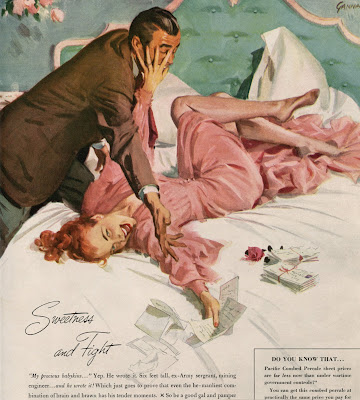Anyone with the courage to take a fresh look at the role of art in the 20th century might reasonably conclude illustration has played a more significant role than "fine" art.Last weekend I gave a lecture at the Norman Rockwell Museum in Stockbridge Massachusetts. The following is an excerpt from what future generations shall call my NRM Manifesto (unless the NRM lawyers demand that I remove their name, which is quite possible):
Yeah, you heard me-- more significant than Picasso, Matisse, Jackson Pollack and the great Jeff Koons combined.
Absurd? Perhaps. But let's explore the issue as soberly and conscientiously as we are able, and see where the facts take us.
We should start by agreeing there are many legitimate methods of measuring the importance of art. For me, the least satisfying method seems to be the most popular: to blindly accept the conventions of our grandparents who instinctively assigned a lower social status to "commercial" illustration.
What might be a better test? I submit that four of the most relevant standards for measuring the significance of art are:
- The size of its audience
- Its economic impact
- Its effect on society
- Its impact on our individual lives
Size of the Audience: In a century when many towns did not have an art museum, a gallery, or even a public library, the average citizen has been surrounded by illustrations. They invaded his field of vision from all sides. The Saturday Evening Post, chock full of illustrations, was selling three million copies while its rival Colliers was selling nearly as many. Illustrated magazines arrived in mailboxes all across America, along with illustrated brochures from car manufacturers and other advertisers. Illustrations in storybooks, billboards, posters and animated movies found their way to every corner of the globe, driven by the mighty engine of commerce. By comparison, attendance at museums and galleries, and the sale of fine art books and prints, was meager at best. If we judge by raw numbers, Norman Rockwell enjoyed far more viewers Picasso.
 |
| The Gibson Girl set a popular standard for beauty |
 |
| The Arrow Collar Man |
 |
| John Held established the flapper as an institution |
 |
| Peter Max's psychedelic style became emblematic of his era |
What ultimately matters in art is not the canvas, the hue of oil or tempera, the anatomical structure and all the other measurable items, but its contribution to our life, its suggestions to our sensations, feeling and imagination.
It would be hard to find a more powerful statement of outrage against the atrocities of war than Picasso's famous Guernica:
Yet, if you want to inspire people to put their lives on the line, to enlist and fight against those atrocities, illustration has historically proven more persuasive than Guernica or any other fine art:
 |
| James Montgomery Flagg |
 |
| Henry Raleigh |
Putting aside the emotions of hate and fear, and looking instead to emotions of love and lust, romantic illustrations in women's magazines played a huge role in shaping women's concepts of what love was and how it worked.
 |
| John Gannam detail: should we have sex before marriage? |
Pictures such as these in Redbook, Cosmopolitan, McCall's, Ladies Home Journal and Good Housekeeping had blood racing and nostrils flaring all across the country. (Meanwhile, husbands were developing their own concept of romance from the pinup illustrations of George Petty and Gil Elvgren.)
Romantic illustrations that shaped expectations and fleshed out our vocabulary weren't limited to fiction magazines. The language of love was spoken in John Gannam's ads for bedsheets as well:
 |
| "My precious babykins..." |
Now take a look at the kinds of statements famous fine artists have made recently regarding the subject of love:
 |
| Damien Hirst, All You Need is Love |
 |
| Robert Indiana, Love |
Tells you something, doesn't it?
There are plenty of other emotions besides love and hate where it might be useful to compare illustration and fine art, but a blog post is not the best place to attempt it. But applying Venturi's test to the representative examples above, it seems clear to me that illustration has had greater significance.
The four standards I have suggested are not the only ways to measure significance, and I would welcome any counter suggestions from readers. In addition, I have not tried to assert which art form has the highest inherent "quality." I have my personal views on that subject (as does everybody else) but it is far harder to devise standards for measuring quality than for measuring significance.
In order to play this game, my only restriction is that you have to be willing to abide by Isaac Newton's famous admonition for honest scientific results:
By looking at the phenomena, I deduce that illustration seems to have been a more significant form of visual art over the past century than "fine" or "gallery" art. But if you have other phenomena for us to consider, or other standards to apply, I'd be interested.I frame no hypotheses; for whatever is not deduced from the phenomena is to be called a hypothesis, and hypotheses, whether metaphysical or physical, whether of occult qualities or mechanical, have no place in experimental philosophy.





















